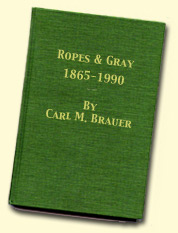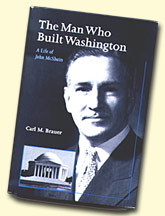|
||
|
EXCERPTS FROM BOOKS WRITTEN BY CARL BRAUER
Presidential transitions and the administrations that follow are the shadow of the man—or, someday, the woman—who heads them. They silhouette his past experience and future goals, strengths and weaknesses. Like shadow and background, the strengths and weaknesses often exist side by side. . . . . Although a long-term view would lead to skepticism about the likelihood of much changing when the Presidency changes hands, Presidents-elect, the press, the public, and even Congress, are apt to take a more hopeful view. Man’s innate and Americans’ especial fondness for the new, relief at the end of a partisan season and the passing of a fatigued administration, and celebration of the orderly transfer of democratic authority together create an atmosphere rife with possibility, which newly elected Presidents should prepare for, nurture, and exploit. The first few months in office are popularly called the President’s honeymoon, and like real honeymoons they often do not quite live up to expectations.  Presidential Transitions: Eisenhower Through Reagan (Copyright 1986, President and Fellows of Harvard College.) Shortly after the U. S. Supreme Court upheld advertising by lawyers in 1978, Simon Rifkind, the legendary New York litigator and former judge, wrote sadly to Justice Lewis F. Powell, Jr: "I could not help feeling that the notion I had all these years that I was engaged in a great and noble profession was a presumption and a fantasy – that really, I was a plumber or a butcher. I am glad that the time I have left for the continued practice of that kind of a profession is now short." Had Ropes & Gray’s partners been privy to Rifkind’s lament about the crass commercialism that had infected the legal profession, many undoubtedly would have concurred in it.  Ropes & Gray, 1865-1990 (Copyright 1991, Ropes & Gray.) The Tullis proposal was scrutinized, praised, condemned, and refined, while its author suffered a certain amount of resentment from the staff. Tullis could later recall with wry amusement how the doctors’ conference room in the cafeteria would empty out when he entered. To be sure, many doctors who disagreed with Tullis maintained their admiration and respect for him; even his detractors conceded his brilliance, and there were a number of staff members who tacitly or openly agreed with his diagnosis and prescription for the hospital.  New England Deaconess Hospital: A Century of Caring (Copyright 1995, Deaconess Hospital.) Yet despite all his accomplishments [which included the building of the Pentagon, the Jefferson Memorial, the State Department, National Airport, the John F. Kennedy Center for the Performing Arts, the rebuilding of the White House during the Truman administration, and the completion of the National Shrine of the Immmaculate Conception,] McShain is not widely known today. Although many Washingtonians probably cannot identify L’Enfant, there is at least a L’Enfant Plaza stop on Washington’s Metro; there is no "McShain Plaza." Visitors to Washington can see McShain’s brass plaques on numerous buildings, but few probably bother to read such plaques or even know where to find them. Indeed, it is doubtful that many people can name the great builders in history, as opposed to the great architects or planners. Even if a builder is famous in his own day, he usually fades into obscurity. The great architects and planners are remembered, memorialized, and studied, while the great builders are forgotten and ignored.  The Man Who Built Washington: A Life of John McShain (Copyright 1996, Hagley Museum and Library.) Although a number of hospitals, including Massachusetts General, adopted some features of the End Result System and a few hospitals adopted virtually all of it, the system as a whole fell by the wayside. Even if Codman himself had been tactful and politically skilled, however, it is unlikely that the End Result Idea would have gotten much further than it did. The idea was difficult, costly, and threatening to the reputations of both doctors and hospitals. They liked to trumpet success, but preferred to downplay failure. Moreover, practically no incentives existed to implement it. Seventy and eighty years later, when another attempt was made to focus on outcomes research and implementation, incentives were stronger, but it still did not come easily or without struggle.  Champions of Quality in Health Care: A History of the Joint Commission on Accreditation of Healthcare Organizations (Copyright 2001, The Joint Commission on Accreditation of Healthcare Organizations.) |
|
|
||

